 |

|
Friday Qualifying 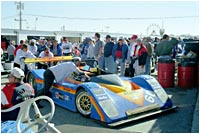
It's a calm Friday afternoon in Daytona, Florida, and 70 year old David Kopf is relaxing with friends. The Can-Am car he designed and built is awaiting today's final qualifying session for tomorrow's running of the 36th Rolex 24 at Daytona. Everything seems ready, and the car is being given a series of final checks by the team's crew chief Chris Wakim. The final set of matched Dunlop racing slicks has been selected and placed on the car. This same set, used in qualifying, must be on the car at the beginning of the race tomorrow, and will be marked by officials to ensure this. Everyone here knows that the car is capable of improving on yesterday's qualifying times, and they are determined to do so. 
The mood in the paddock is high among all of the teams. It's qualifying, everyone is hopeful, and even though the first few positions were set in yesterday's qualifying rounds, everyone still has a shot. The cars are beautiful. The low-slung, purposeful, pure racing wings that make up the Can-Am cars. Their low carbon fiber fenders and wings covering advanced suspensions and powerful engines. Across the way, the long-nosed, batmobile looks of the Panoz, sporting its new silver paint scheme, and it's class rival, the sleek Porsche 911 GT1s. Porsches are everywhere in fact, "…like fleas on a dog's back" according to Can-Am racer, Kopf "seems there's always some Porsche in your way." The venerable 911, in one form or another comprises the bulk of the competitors in the GT classes. They would in fact dominate all three GT classes if it weren't for the tenacious BMW M3s of Tom Milner's Prototype Technology Group. American iron is also represented in GT racing by a number of Camaros and Mustangs, even a few Oldsmobiles. Like everyone else, the Kopf team is excited. Three thousand miles from home, they have come here to run Daytona, arguably America's most important professional road race, and certainly its toughest. As the time approaches for final Can-Am qualifying, David excuses himself from the people who have gathered around him, now he is all business. This is why he is here. Immensely loud roars, a series of explosions, come from each garage as engines are fired up. The American V8s contrasting with the turbocharged German flat-sixes and Italian twelves. Crowds make room in the paddock as cars come through and it's begun. Cars are on the track. 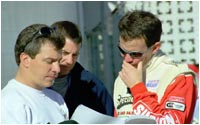
Yesterday wasn't perfect for the Kopf team. It had been decided in the off-season to rebuild the car's entire rear structure to accept an Eades transmission. Unfortunately, the transmission arrived late from the manufacturer, forcing an accelerated redesign and rebuild of the drivetrain and rear suspension. Naturally, testing of the new componentry suffered as well. The team arrived at Daytona Thursday morning with a very new racecar. During qualifying and testing on Thursday, the drivers had noticed that the new transmission was jumping out of gear under hard acceleration in the low speed corners of the infield section. This was a problem for the team, considering how much time, effort, and money had been invested in the new box. 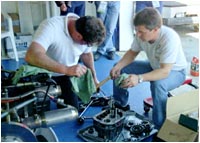
Driven to find the problem, David and his crew proceeded to tear into the transmission only to find that it was fine. While investigating a separate report of some mild chassis-flex, Chris found that the studs connecting the bellhousing to the transmission were broken. That evening, the crew removed the entire rear end from the Keiler and installed stronger, harder studs to take the stresses generated by the suspension. David has a more permanent fix in mind which will remove the stress from this drivetrain joint, a lightweight member between the transmission and the bellhousing, always in compression. Unfortunately, this will have to wait until after the race when the crew returns to California. That was last night, and today, Friday, the Keiler is just flying. In morning practice Shane Donley had turned some really fast laps and the team is pumped up for afternoon qualifying. David knows that the morning times were handicapped by low tire pressures in the big Dunlops, and the car can run even faster. Out on the track time is running and Kris Wilson has already cut almost two seconds off of yesterday's initial qualifying time. The car is somewhat loose in this session, which is nearing an end when problems hit. As Kris is exiting the east banking, approaching the grandstands, the rear suspension collapses and the car is on the ground sliding along at over 180 mph. He can control it enough to get it off of the track and onto the grass in front of the pit entrance where it comes to a stop. Kris is fine and qualifying ends under full course yellow as the Keiler is towed back into the paddock. The crew knows they have a long night ahead of them, and they can't be happy about it. After all, they won't be sleeping tomorrow night either. |

David Kopf As a designer, inventor and manufacturer of medical research instruments, fine mechanisms and precision machinery have been David Kopf's trade since the fifties. David was always a car enthusiast, but came late to sports car racing, having spent his earlier years working with people like Frank Kurtis and his Kurtis Offys. He began racing vintage cars in the early eighties, competing in well over 150 races throughout the US and Europe over the years, including some very notable events. In addition to running in multiple Mille Miglias, David was the first American since Phil Hill to win a race at the Nurburging. David also has quite a few other firsts, at places like Willow Springs, Road America, Watkins Glen and Summit Point. In a particular Summit Point race, he did so well on the first day of the event in his B16 Chevron Coupe that, despite a blown engine and a failure to run at all on the second day, the car still placed 16th overall. David ran that car in 39 races, and won 32 of them. Most of the vintage cars are gone now however. David's a racer, not a collector. "There's no reason to keep them around if you're not racing them, they just take up space," he says. Chevrons have always been a big favorite of David's, and in 1995 he approached the Chevron factory to build him a new car. The car would be a new Chevron designed to run in the IMSA World Sports Car class, now Can-Am. This was not the same Chevron who had built the cars he loved however. A change of ownership and direction left a company he felt was substandard to the original Chevron, and after a lot of money, and a lot of frustration David realized that this company was not going to build the car he needed to be competitive in Can-Am. 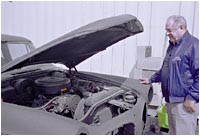
His experience with racecars, and his extensive knowledge of precision machinery gave him only one option. David would design and construct the car himself. It wasn't an entirely new realm for him. Since he had been racing the vintage machines, he had built up quite a reputation as a fabricator, and not only did he build components required for his cars, but his services were in demand by others as well. Kopf Precision Race Products had been in business for some time, and now it would build its first modern sports car, the Keiler. |
|
The Keiler KII The word Keiler is German and is the name of a particularly ferocious wild boar, a very determined animal. The Keiler is the leader of the pack, and is completely driven to his intended goal, like David. The Kopfs, David and his wife Carol have a large collection of wild boar paintings and sculpture, and when it came time to name David's new race car, The Keiler was a natural. 
The Keiler went from concept to initial testing in only 14 months. A major undertaking, the car was designed electronically using a state-of-the-art computer modeling system provided by a sponsor, CAD/CAM Consulting Services, in Newbury Park California. Tom Sheler and Brian Gillespie of CAD/CAM also provided training so that David, then in his sixties, could participate in the design on the computer, as well as in the machine shop. Since then, Kopf Precision Race Products has become completely computerized, with CNC mills big enough, and automated enough to build engine blocks overnight. This is not a small operation, and it's not cheap. In addition to building the Keiler, the shop has been selling its services to build replacement parts for other racing teams as well. This however, is all a prelude to David's real goal, selling Keilers to paying customers. To do this, the car must do well on the track, it must prove itself. |
|
Saturday Morning No one seems to have suffered to much from the late night, but that may be the excitement and adrenaline of the day, today the race begins. Shane Donley has been out this morning testing the repaired Keiler, and he's happy. Gone are the problems that hurt them in qualifying, the car is stable and fast. A discussion with David and the crew chief results in a decision to change third gear. Changes made last night to allow the car to run faster at lower RPMs in fifth have resulted in some odd gear spacings, and a new third should cure this. The crew begins to dismantle the transmission. Despite the added work, everyone's in great spirits. The running joke in the garage is that Shane is going to be in trouble with the France family, who own Daytona and NASCAR, as well as a big stake in USRRC. Apparently, despite the fact that it was Kris who drove the car onto the well-tended, bright green grass in front of the main grandstands here at Daytona, ESPN2 reported that Shane Donley was driving the car. Everyone jokes that there would have been more than suspension troubles had they driven it onto the painted Daytona logo. 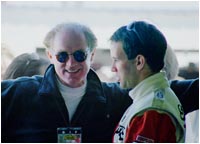
The three drivers, Shane, Kris and Tim Moser are discussing the course and getting psyched for the next 24 hours. They are preparing themselves and each other. Recommendations about line and braking in particular turns as well as words about possible problems, where to pull off in case the worst happens. The race's grand marshall, and Shane's friend, Derek Daly stops by to give him a pep talk. Shane Donley hasn't run a 24 hour race yet, and Derek's been there, and won. He coaches him, "Discipline, it's all discipline in a race like this. His natural tendency is to run fast because he can" says Derek. But Shane is aware of this, as a racing instructor he tells his students this all the time. Maybe all driver's need to be reminded of this before a race, especially a 24 hour race. |

Shane Donley Shane's parents are incredibly proud of him. Whatever he's driven has gone on to win big. He began racing Karts at 13 and went on to two national championships. His father, a racer himself, remembers Shane giving him driving advice for his Pony Stock car in Southern California. "Shane would give me driving advice" he says, " so I figured that the best way for the car to win was to cut a hundred or so pounds out of the driver's seat by putting him in it!" Subsequently, Shane went on to tear up the small circle tracks in SoCal when he wasn't racing karts. 
His driving talent has led him to bigger and faster cars. In 1997, at 26 years old, he took the Western National Championship in the Barber Dodge Amateur Series, winning six fully paid races in the Barber Dodge Pro Series. His success in France, at the Elf-Winfield School, and with Formula Renault cars led him to a spot in the Team Green Academy, declared one of the top 25 young drivers in America. 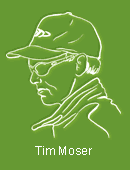
Shane is determined to become an Indy Car champion someday, and drives formula cars every day as an instructor at the Derek Daly Speed Centre racing school in Las Vegas. Which brings us to David Kopf. David, attending a refresher course at the Daly school was so impressed with Shane's abilities that he offered him a seat in the Keiler. Shane joined the team part way through the 1997 season, helping the team to its best finish yet, a ninth at the season finale at Laguna Seca. Shane isn't the only champion on the team, nor the only race instructor. Both Kris Wilson and Tim Moser have national championships under their belts, Wilson in F2000 and Moser in Barber's Formula Ford series, they've also both won Rookie of the Year honors in various series. Interestingly, all three drivers instruct as well, Shane Donley for Derek Daly Speed Centre, Kris Wilson for Russell Racing, and Tim Moser for Skip Barber. 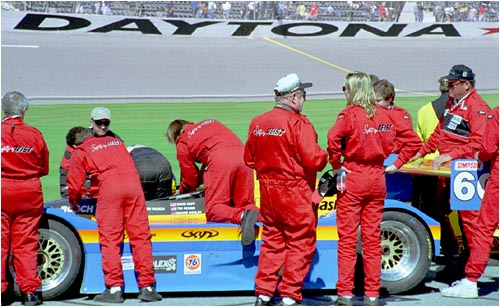
|
|
1:03 pm 
Shane is buckled into the Keiler as it sits angled across the pit lane with all of the other cars awaiting the call for engine start. The crew is gathered around, everyone in their bright red Deist safety suits. It's getting warm and everyone is a little tense. Photographers walk up and down the grass in front of pit lane getting pictures of the machines and their crews. 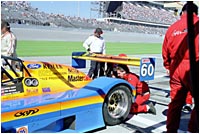
As the cars roll out onto the track though, there is a problem. The 60 car, the Keiler isn't going anywhere. The assistant crew chief, Victor Hertfelder has noticed a leak in the transmission cooler. This is too soon, they should be out on track in their starting position. The car is hustled over to the hot pit and the rear end is pulled off. 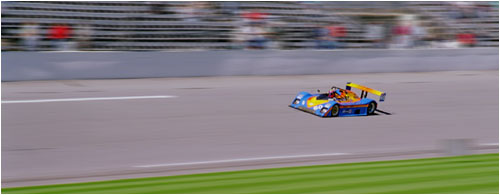
Forty minutes later, at the first fuel stop, the car is brought in for a more permanent fix to the transmission cooling problem. Apparently during Kris' incident last night a rivet punctured the oil cooler, and it didn't show up during this mornings warmup. The problem is fixed, and Shane heads back out onto the track. When he comes back in, the engine sounds bad, something is broken. It turns out that the number one header pipe has cracked, this will cost the team more time, and the car is brought back behind the wall to weld the broken header. At the end of his session Shane relinquishes control to Kris Wilson. 
Luck is not with the team today however, and less than an hour into Kris' session something has gone very wrong. The car has lost all power and caught fire. The car arrives back at the pit with engine problems and on fire. Chris Wakim jumps over the wall with a fire extinguisher to put the fire out as fire marshalls stand by and watch. Three other cars would be lost that weekend to fire, Chris saved the Keiler though. Nevertheless it looks like their race has been run. As the Keiler is rolled back to the garage, the white fire extinguisher dust covering the rear end, the crew looks upset. This is real bad. The bodywork of the car is removed, exposing the engine and a destroyed number one cylinder. Their race is definitely over. Everyone is upset and despite the noise outside, it seems much quieter in the garage. 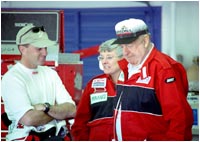
Later that night, the team is gone. Garage 35 is completely empty except for the ubiquitous rented nitrogen bottles stood by the door. The team has packed up. Some are watching the race, some have left. Their hot pit has been given over to one of the unfortunate crews who were doubled up in another, and for another 21 hours the race goes on. Attrition is a major part of competing in a 24 hour race, but is it harder or easier to have to drop out in the beginning? |
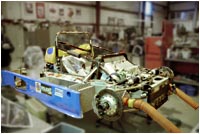
The Future David Kopf hasn't given up, not by any means. He has taken the car and the crew back to California to get ready for the remainder of the USRRC Can-Am season, as well as Professional Sportscar's WSC events. In addition to this, Kopf hopes to take the car to Le Mans this year or next. 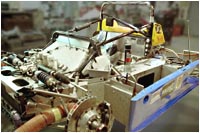
He knows that the Keiler will run fast, and that it can lead. In addition, Kopf has some of the best young drivers in the country working for him, all of them with more national championships in their future. When things come together for this team, you can expect to see them running up front on the last lap, and that's when it counts. |
comments? questions? corrections? e-mail?
Digital photos (Paddock) taken with an Olympus D300L digital camera at low resolution setting.
Track photos shot in 35mm with a Nikon F2020 or 6006 and a Sigma 28-200mm or Tamron 90-300 lens.
35mm negatives scanned with a Minolta Dimage Scan Dual slide/negative scanner.
Photographs, story, and digital artwork copyright 1998, Michael Wendell.
Not to be reproduced in any form without written permission.
 Every car is shining like new, they won't look anything like this in a few hours, and many won't be here this time tomorrow. Then it comes, the grand marshall, Derek Daly announces "Gentlemen, start your engines" and the cars come to life in a single cacophonous roar that is probably heard and felt halfway to Orlando. Standing behind the cars in the hot pit, you can't help but smile a big stupid grin. The sight of all the primary colors of crew and cars combines with the great noise and unique smells that make up racing. Here we go.
Every car is shining like new, they won't look anything like this in a few hours, and many won't be here this time tomorrow. Then it comes, the grand marshall, Derek Daly announces "Gentlemen, start your engines" and the cars come to life in a single cacophonous roar that is probably heard and felt halfway to Orlando. Standing behind the cars in the hot pit, you can't help but smile a big stupid grin. The sight of all the primary colors of crew and cars combines with the great noise and unique smells that make up racing. Here we go. Tools are flying over the wall and Chris is bypassing the transmission oil cooler to get the car on the track for the start. Before the cars come by on the first pace lap the Keiler is heading out of the pits, but any starting position the team may have had has been lost. Shane will have to start in last place.
Tools are flying over the wall and Chris is bypassing the transmission oil cooler to get the car on the track for the start. Before the cars come by on the first pace lap the Keiler is heading out of the pits, but any starting position the team may have had has been lost. Shane will have to start in last place.